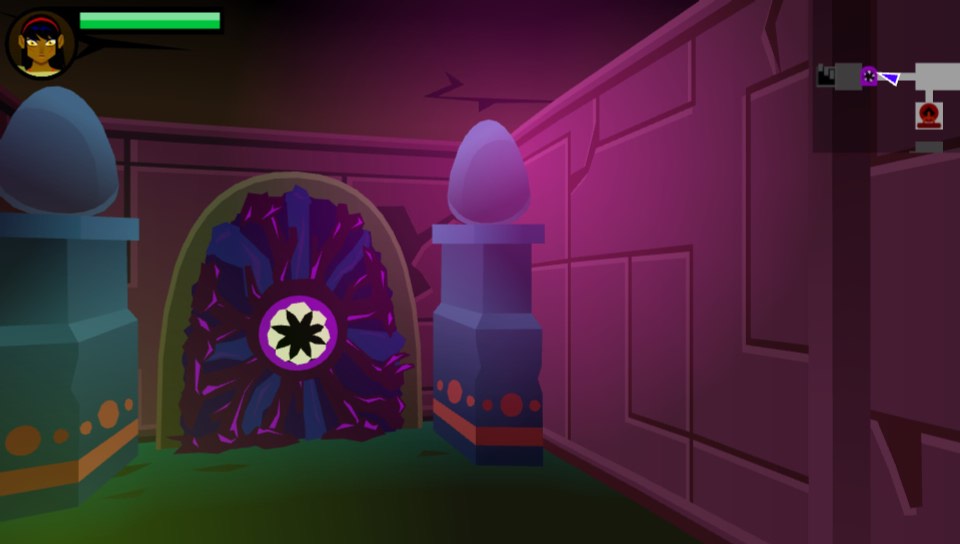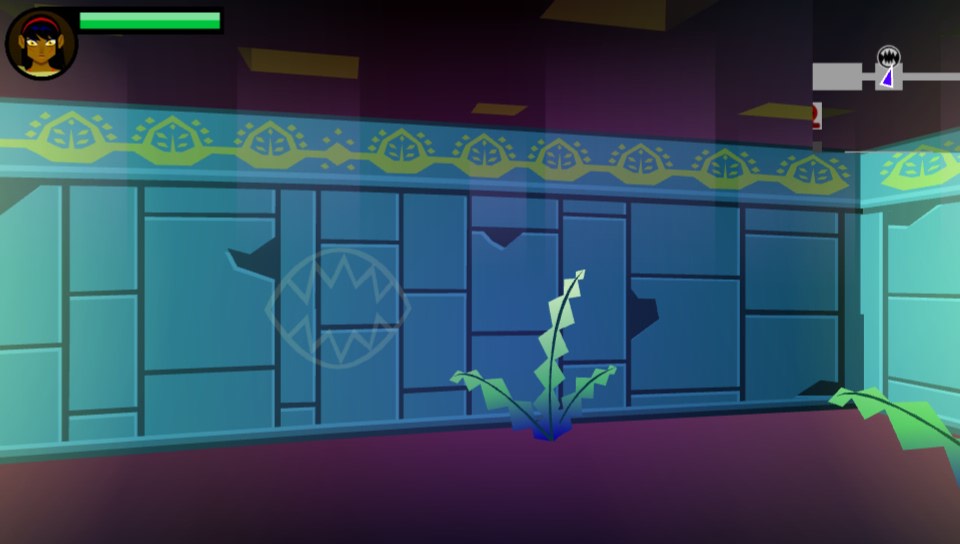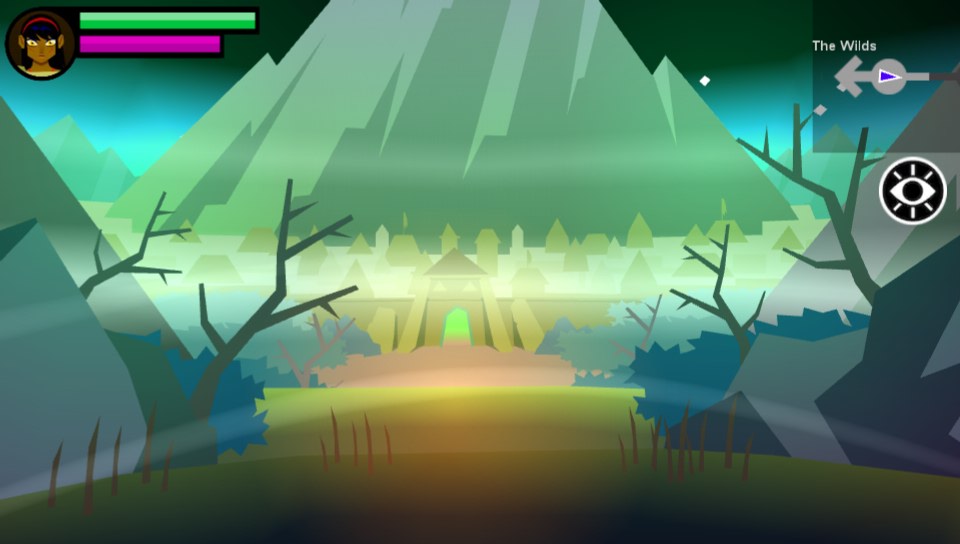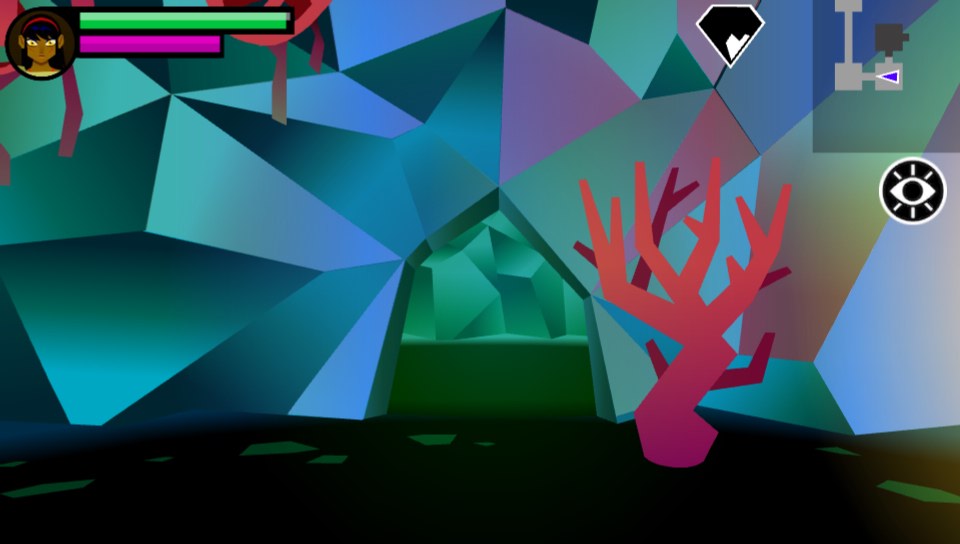Top-notch organ and level grinding.
The last Playstation Vita game I reviewed was back in February 2014, two months before I got to see just a trailer for Drinkbox Studio’s Severed. Then, I originally expected to see Severed first during the Spring of last year and then last summer. So to see it come out now brings doomsaying regarding its success this late into the Vita’s lifecycle. Now that I’ve been very anxiously awaiting its arrival for two years, it has a lot of my own expectations to live up to and a lot of people to convince, who may have abandoned their Vitas due to poor overall support or have been fence-sitting all this time. Though I lack the credentials to predict purchasing habits for any demographic, I believe Severed possesses enough great qualities to make it a unique lure to the Vita before it gets put to bed.
Your introduction to Severed's setting begins in an empty valley, and you move along the single path towards a trashed home, presumably yours, until you look in the mirror and greet your reflection, Sasha. With her right forearm missing, the stub bandaged with blood soaking through, our Mesoamerican protagonist looks alarmed and forlorn, remembering her family being taken from her—along with her appendage—by some multi-headed beast. Before she has a moment to grieve her loss, a mysterious figure appears behind her, tells her this is not her world, and offers a living sword with which she may exact her revenge. She's told that retrieving the bodies of her family members and returning them to the house may let her return to her real home. And so the adventure begins.
With a sword at your control, Severed utilizes the Vita’s touchscreen predictably, allowing you to slash frenetically at your beastly foes. However, combat does not dissolve into mindless slashing like Fruit Ninja. Enemies are not just fencing dummies thrown to the slaughter; they can block and attack, and moreover, each one operates differently from the next. The four-armed foe you first meet will eventually build its attack, evidenced by a growing yellow ring around its icon on the bottom of the screen, and when it turns red, it will raise an arm to attack. At this point, by swiping the screen in the opposite direction of the incoming blow, you can parry and get a few extra slashes in.
Other enemies, such as one that seemingly grows a tree of fungus periodically, have attacks that cannot be blocked. Instead, you must slash at them to set the yellow ring back. When surrounded by a group of enemies, it's managing all of these behaviors, facing one enemy on the screen at a time, that you will meet success.
These combat scenarios authentically feel like puzzles, and with each new enemy encountered, you develop an understanding of the language the game speaks to progress. Luckily, the price of defeat, typically via loss of health, is only being set back a room or so thanks to the frequent checkpoints, allowing you to try again. Enemy encounters are also commonly telegraphed by the sight of a small white flame in whichever room they’re waiting in, so except for a handful of surprises, you can make decisions to forge ahead or go exploring down other paths while you figure out a strategy. Once you do surpass an enemy encounter, it never returns, allowing you to search your surroundings more thoroughly, but some of the more challenging battles block desired upgrades and additional pathways.
One of the most important facets to combat is the focus meter. You build focus by landing continuous hits on enemies without being blocked or attacked, increasing the need to learn their patterns and develop some kind of strategy for attacking them. Once the meter is full, the titular Severed mode is activated. Defeating an enemy at this point, will briefly slow down time, position the foe susceptibly, and reveal specific weak points on their body. By executing precise slashes along these lines, you can cut off particular parts and organs, which can be used to upgrade Sasha’s abilities. This function, aside from being fun, is vital to getting through Severed, as even in the toughest battles, they can help you regain health, increase your strength, or gain an upper hand somehow.
The game is split roughly into three acts, one for each family member Sasha is trying to retrieve and each involving a journey into a temple of some sort and a boss fight. In each one, she gains a new ability, such as being able to freeze an enemy for a short period of time or steal stat buffs the enemies employ. It’s worth noting that during the second act, combat difficulty spikes significantly. I never found the challenge for the main path insurmountable, but it requires a more sudden acclimation to the flow of battle than I was expecting. Particularly in sections where your health depletes slowly, you’re suddenly a few wrong moves away from repeating a battle three or four times.
Dungeons and the surrounding area are mapped out in nodal style, forcing players to progress one “room” at a time, though allowing them to look in 360° in each one. Unfortunately, when not in battle, the touchscreen in these rooms remains barely utilized, simply used to pick up items, activate levers or abilities, or to break vases in the hopes that they contain giblets, which eventually can be converted into organs with the relevant ability unlocked. Although the common functions of a touchscreen—swiping, tapping, and long-pressing—are implemented in some way, there just aren’t a ton of interactive elements besides those that aid your progress forward.
Keeping this in mind, it bleeds into an issue I have with the narrative overall. The setting of Sasha’s revenge fantasy remains a complete mystery for the entirety of the game. Although she goes on something of a journey herself, and there are a few other characters of note, there are no opportunities to build out her past or that of the world she inhabits. Like a tease, the combat tutorial takes place in a flashback, inspiringly showing Sasha’s mother teaching her to wield a sword, but that’s the last one you experience. And despite an emotionally resonant finale, its potential to grip players’ heartstrings is mitigated by the utter lack of any opportunities to bond with Sasha’s family. And these vastly complicated networks of nodes leading her from one encounter to another do not betray their histories whatsoever. Despite some astounding and memorable graphical work to build out these beautiful environments, they just fail to manifest as more than dressing for a straightforward tale.
Regardless of my gripes with the narrative, I enjoyed Severed very much. Combat is a ton of fun to figure out, with each encounter having its own unique flavor and some challenging me to keep coming at them again and again until I mastered them. Also, as a result of the abilities Sasha gains through the plot, upgrades notwithstanding, the game takes on a Metroid-vania style, allowing players to find heart and brain pieces—collect five of either to expand health and mana respectively—or more body parts to fortify themselves. The upgrade screen, which lets you spend these parts, is also a treat in its own way, showing Sasha’s transformation as she continually dons new armor or weapons, turning into something of a monster herself and looking completely badass.
The nodal style of the map both helps and hinders the game in its own way. Mostly, it enhances that “just one more” aspect to gameplay that keeps you playing well longer than intended, especially where there are no enemy encounters visible in the next room. And the map itself conveniently marks significant doorways and their statuses, rooms with still-locked secrets, and upgrades hiding just beyond reach. If you can see it, it’ll appear on your map even if you’re hours away from retrieving it, making it easier to remember later on.
However, moving one-by-one across each area, even with enemies cleared, can be very cumbersome, likely prohibiting some players from wanting to fully explore each area. I admit to being stubborn about exploration, hence my desire for more environment-related collectibles and interactions, but I found backtracking a bit tiresome now and again. It also doesn’t help that the floorplans are so complicated that you will need to refer to the large map often to navigate. A fast-travel system could’ve gone a long way in this regard, though the game throws something of a shortcut-like bone in its final third. It’s helpful-ish.
Besides the combat, I mostly enjoyed the whole presentation. Coupled with the aforementioned attractive graphical work is an exciting musical score. Comprised of some multi-cultural orchestral instrumentation, electronic synths, and a ton of prog rock work, it’s a standout experience in this creative game. Yamantaka//Sonic Titan and Pantayo, two female-fronted Canadian bands, combined forces to create a soundtrack that’s appropriately ambient or thrilling, given the situation, but always a little to a lot unnerving. The unnamed world Sasha is trapped in feels all the creepier as a result and goes a long way to establish the continuous air of unfamiliarity that makes it compelling. Again, I wish there was more to interact with in the game to enhance the visual and aural experience.
Overall, Severed does a lot of good with its excellent and challenging combat, intricate dungeon maps full of collectibles, unique and visceral upgrade system, and a fantastic presentation. Its biggest shortcoming is its lack of opportunities to engage with its world and Sasha’s history, but with everything that works so well about the game, I can mostly forgive this slight. My roughly nine-hour experience was a great joy, filled with memorable sights, sounds, and (physical) touches. Maybe, like Okami for Playstation 2, it will be the console’s swan song, but it is hard to discredit a unique experience like this one purely for coming to the party so late.
-
Beautiful, distinct graphics
-
Excellent soundtrack with varied influences
-
Engaging combat with a puzzle-like quality to its strategy
-
Sudden difficulty spike in second act
-
Lack of touchscreen use for greater interactivity with environment
-
Badass female protagonist of color
-
No opportunities to flesh out story about world or Sasha's past
-
Nodal quality to map encourages "just one more" approach to play
-
That same quality also makes backtracking a bit tiresome
Severed Review
-
Severed Review #1

-
Severed Review #2

-
Severed Review #3

-
Severed Review #4

-
Severed Review #5

-
Severed Review #6

-
Severed Review #7

-
Severed Review #8

-
Severed Review #9

-
Severed Review #10

-
Severed Review #11

-
Severed Review #12

-
Severed Review #13

-
Severed Review #14

-
Severed Review #15

-
Severed Review #16

-
Severed Review #17

-
Severed Review #18

-
Severed Review #19

-
Severed Review #20












